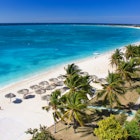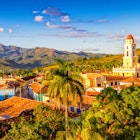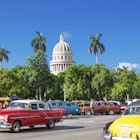
Dec 15, 2025 • 7 min read
The wilderness areas of Cuba's national parks conceal a tremendous number of unique species and are practically unknown to foreign visitors.

Dec 15, 2025 • 7 min read
The wilderness areas of Cuba's national parks conceal a tremendous number of unique species and are practically unknown to foreign visitors.

Dec 9, 2025 • 8 min read
You may head to Cuba for the beach, but the country's hiking landscape across its little-explored network of national parks is truly an unsung hero.

Dec 9, 2025 • 5 min read
Cuba's beach scene is impeccable, from its white sand and crystal clear waters to its relaxed feel and countless outdoor activities.

Dec 2, 2025 • 6 min read
You'll find plenty of ways to keep your kids entertained in Cuba, from frolicking in the Caribbean sea to searching for wildlife and more.

Aug 26, 2025 • 6 min read
Cuba's top destinations delight travelers with music-filled cities, chill resorts and remote natural beauty.

Jul 30, 2025 • 12 min read
Experience the best of Cuba with our pick of the top things to do.

Feb 3, 2025 • 4 min read
Check this seasonal guide to Cuba's lively festivals, top beach weather and budget prices to find the best time for your visit.

Jan 28, 2025 • 8 min read
Get ready to uncover the buoyant and sophisticated magic of Cuba. Here are the top things to do on your visit.

Jan 18, 2024 • 4 min read
Travelers often have questions about the visa process for Cuba and whether US citizens can even visit. Here’s our guide to Cuba’s visa requirements.

Jan 10, 2024 • 7 min read
You can still see the best of Cuba even without a huge budget. Here are our tips on getting the most out of your money.

Jan 6, 2024 • 7 min read
From beaches to mountains to historic cities and more, these road trips around Cuba offer access to the best of this enchanting island.

Nov 11, 2022 • 3 min read
Headed to Cuba soon? Don't go until you read Cuba expert Brendan Sainsbury's top tips on currency in the country.

Sep 13, 2022 • 11 min read
Here’s where to find the best traditional dishes around the country.

May 20, 2022 • 5 min read
The US has taken several steps toward thawing US-Cuba relations after five years of tightened restrictions. Here's what Americans need to know about traveling…

Feb 3, 2022 • 5 min read
Classic cars are a popular tourist attraction in Cuba. Here's how to book yourself the perfect tour in an iconic vehicle.

Dec 31, 2021 • 8 min read
Lonely Planet's Cuba travel expert visits the tropical island and reports back about his worthwhile trip.

Oct 27, 2020 • 8 min read
Travel writer Brendan Sainsbury is an expert on travel to Cuba. This is his first time returning since the global pandemic began.

Jun 16, 2020 • 5 min read
For decades, Cuba's female professionals have been redefining the country's art scene and exploring new avenues for income.

May 7, 2020 • 3 min read
Whether it's the fluid movements of salsa dancers, the blare of a trumpet or the waft of cigar smoke in the air, Cuba is a country that lingers in the mind.

Sep 3, 2019 • 7 min read
Despite a well-publicized announcement by the Trump administration in June 2019, it is still relatively easy for Americans to travel legally to Cuba.

Jun 12, 2019 • 4 min read
In the space of three years, US-Cuban relations have gone from cagey cooperation to the tetchy squabbling of yore. On June 4, the Trump administration…

Jun 5, 2019 • 3 min read
Travel to Cuba just got more difficult for Americans after the Trump administration announced a ban on cruise ships, private planes and boats to the…